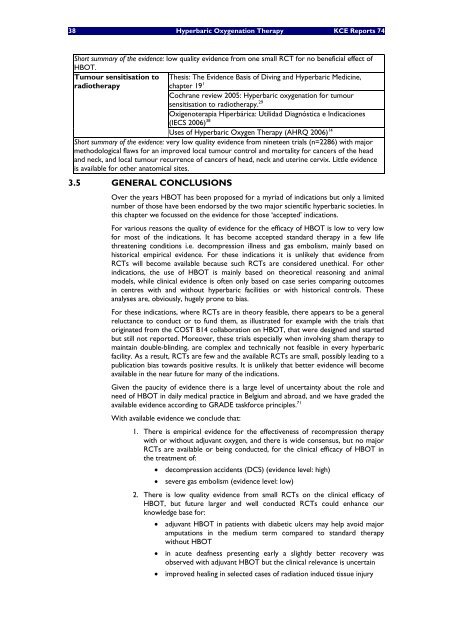Download the full report (130 p.)
Download the full report (130 p.)
Download the full report (130 p.)
Create successful ePaper yourself
Turn your PDF publications into a flip-book with our unique Google optimized e-Paper software.
38 Hyperbaric Oxygenation Therapy KCE Reports 74<br />
Short summary of <strong>the</strong> evidence: low quality evidence from one small RCT for no beneficial effect of<br />
HBOT.<br />
Thesis: The Evidence Basis of Diving and Hyperbaric Medicine,<br />
chapter 19 1<br />
Cochrane review 2005: Hyperbaric oxygenation for tumour<br />
sensitisation to radio<strong>the</strong>rapy. 29<br />
Oxigenoterapia Hiperbárica: Utilidad Diagnóstica e Indicaciones<br />
(IECS 2006) 38<br />
Tumour sensitisation to<br />
radio<strong>the</strong>rapy<br />
Uses of Hyperbaric Oxygen Therapy (AHRQ 2006) 14<br />
Short summary of <strong>the</strong> evidence: very low quality evidence from nineteen trials (n=2286) with major<br />
methodological flaws for an improved local tumour control and mortality for cancers of <strong>the</strong> head<br />
and neck, and local tumour recurrence of cancers of head, neck and uterine cervix. Little evidence<br />
is available for o<strong>the</strong>r anatomical sites.<br />
3.5 GENERAL CONCLUSIONS<br />
Over <strong>the</strong> years HBOT has been proposed for a myriad of indications but only a limited<br />
number of those have been endorsed by <strong>the</strong> two major scientific hyperbaric societies. In<br />
this chapter we focussed on <strong>the</strong> evidence for those ‘accepted’ indications.<br />
For various reasons <strong>the</strong> quality of evidence for <strong>the</strong> efficacy of HBOT is low to very low<br />
for most of <strong>the</strong> indications. It has become accepted standard <strong>the</strong>rapy in a few life<br />
threatening conditions i.e. decompression illness and gas embolism, mainly based on<br />
historical empirical evidence. For <strong>the</strong>se indications it is unlikely that evidence from<br />
RCTs will become available because such RCTs are considered unethical. For o<strong>the</strong>r<br />
indications, <strong>the</strong> use of HBOT is mainly based on <strong>the</strong>oretical reasoning and animal<br />
models, while clinical evidence is often only based on case series comparing outcomes<br />
in centres with and without hyperbaric facilities or with historical controls. These<br />
analyses are, obviously, hugely prone to bias.<br />
For <strong>the</strong>se indications, where RCTs are in <strong>the</strong>ory feasible, <strong>the</strong>re appears to be a general<br />
reluctance to conduct or to fund <strong>the</strong>m, as illustrated for example with <strong>the</strong> trials that<br />
originated from <strong>the</strong> COST B14 collaboration on HBOT, that were designed and started<br />
but still not <strong>report</strong>ed. Moreover, <strong>the</strong>se trials especially when involving sham <strong>the</strong>rapy to<br />
maintain double-blinding, are complex and technically not feasible in every hyperbaric<br />
facility. As a result, RCTs are few and <strong>the</strong> available RCTs are small, possibly leading to a<br />
publication bias towards positive results. It is unlikely that better evidence will become<br />
available in <strong>the</strong> near future for many of <strong>the</strong> indications.<br />
Given <strong>the</strong> paucity of evidence <strong>the</strong>re is a large level of uncertainty about <strong>the</strong> role and<br />
need of HBOT in daily medical practice in Belgium and abroad, and we have graded <strong>the</strong><br />
available evidence according to GRADE taskforce principles. 71<br />
With available evidence we conclude that:<br />
1. There is empirical evidence for <strong>the</strong> effectiveness of recompression <strong>the</strong>rapy<br />
with or without adjuvant oxygen, and <strong>the</strong>re is wide consensus, but no major<br />
RCTs are available or being conducted, for <strong>the</strong> clinical efficacy of HBOT in<br />
<strong>the</strong> treatment of:<br />
• decompression accidents (DCS) (evidence level: high)<br />
• severe gas embolism (evidence level: low)<br />
2. There is low quality evidence from small RCTs on <strong>the</strong> clinical efficacy of<br />
HBOT, but future larger and well conducted RCTs could enhance our<br />
knowledge base for:<br />
• adjuvant HBOT in patients with diabetic ulcers may help avoid major<br />
amputations in <strong>the</strong> medium term compared to standard <strong>the</strong>rapy<br />
without HBOT<br />
• in acute deafness presenting early a slightly better recovery was<br />
observed with adjuvant HBOT but <strong>the</strong> clinical relevance is uncertain<br />
• improved healing in selected cases of radiation induced tissue injury

















